Brent Marchant's Blog, page 78
June 13, 2019
‘Rocketman’ celebrates creativity unleashed
“Rocketman” (2019). Cast: Taron Egerton, Jamie Bell, Richard Madden, Bryce Dallas Howard, Gemma Jones, Steven Mackintosh, Stephen Graham, Charlie Rowe, Tate Donovan, Matthew Illesley, Kit Connor, Tom Bennett, Sharmira Harrower, Ophelia Lovibond, Celinde Schoenmaker, Rachel Muldoon. Director: Dexter Fletcher. Screenplay: Lee Hall. Web site. Trailer.
The creative spark within each of us longs to be released. But that typically doesn’t happen until we give it the catalyst it needs to free itself, something we generally don’t supply until we recognize exactly what’s required for that to happen. Sometimes it even calls for elements and influences that we might ordinarily think would be highly unlikely for achieving success. Nevertheless, when these components come together, they can truly work magnificent wonders, a synthesis depicted in the entertaining and inspiring new musical biopic, “Rocketman.”
Young Reginald Dwight (Matthew Illesley) led a quietly challenging life while growing up in London’s Pinner neighborhood in the 1950s. As the often-ignored, often-criticized only child of a frequently absent military father, Stanley (Steven Mackintosh), and a self-absorbed mother, Sheila (Bryce Dallas Howard), Reggie struggled for any attention and affection he could muster, most of which came from his doting, live-in grandmother, Ivy (Gemma Jones). Unlike Reggie’s parents, Ivy could see that her grandson was gifted, even if a bit shy and withdrawn. That became apparent when the young lad showed a natural aptitude for music, most notably playing the piano and being able to compose beautiful melodies virtually spontaneously. His skills were so adept, in fact, that he soon earned a scholarship to the Royal Academy of Music.
Given the development of his talent, Reggie hoped that it would earn him the recognition from his father that he so craved, especially since Stanley was an avid music lover. Unfortunately, Dad continued to ignore and criticize his son as he always had, maintaining the distance that had long existed between them. What’s more, when Stanley learned that Sheila was having an affair with another man (Tom Bennett), he left for good. Fortunately, though, Reggie’s abilities continued to develop in his father’s absence. And, as the reserved tunesmith became a teenager (Kit Connor), he began taking an interest in a style of music that would change his life – rock ʼn roll.
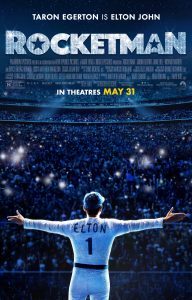
As a young adult (Taron Egerton), Reg and a group of friends formed a band called Bluesology, successfully landing a series of gigs playing backup for American artists like the Isley Brothers and Patti LaBelle and the Bluebelles on tours of the U.K. But, despite the steady work, he grew restless, wanting to break out on his own, something he was at last able to do in 1967, when Ray Williams (Charlie Rowe) of Liberty Records introduced Reg to an aspiring lyricist, Bernie Taupin (Jamie Bell). And, in a move aimed at boosting his charisma, the pianist decided to change his name to something more captivating. Reggie Dwight thus became Elton John, a name that would soon become synonymous with pop music.
Elton and Bernie had a great chemistry from the outset. The songwriting duo joined forces with Dick James (Stephen Graham) of DJM Records, a curmudgeonly music industry pro who expected much but knew that pushing his new talent would pay dividends, as it did with the release of the singles “Border Song” and “Your Song” in 1970. James also helped arrange a live concert at the legendary Troubadour nightclub in West Hollywood, a performance that set the audience – and Elton’s career – on fire.
The young rocker was an instant success, but not just on the stage. Elton soon met John Reid (Richard Madden), an up-and-coming music manager/promoter who would revolutionize his new client’s career. With a string of hits like “Rocketman,” “Crocodile Rock” and “Daniel” and successful concert dates featuring fabulously flamboyant costumes and outrageous stage antics, Elton’s popularity grew by leaps and bounds. More than that, though, as Elton’s love interest, Reid helped the pop star become comfortable with his sexuality, something that he struggled with for years. Even though Elton was not yet ready to come out as a gay man, he was at least finding satisfaction in ways that had always seemed to elude him.

Taron Egerton gives a signature performance as music icon Elton John in the superb new biopic, “Rocketman.” Photo courtesy of Paramount Pictures.
With Reid’s assistance, Elton became a musical phenomenon, soaring to super-stardom in the ʼ70s. However, the pressure of success gradually took a toll. Elton soon became hooked on alcohol and a variety of other recreational substances, most notably cocaine. He also became an out-of-control shopaholic, spending lavishly at every turn. And, if that weren’t enough, he began to see that he was partnered to a philanderer who showed little genuine interest in him, using Elton as little more than a meal ticket.
Elton’s life began to spiral downward as he descended into a life of addiction and sexual compulsion. He desperately tried to drown his disappointment over the breakdown of his relationship, as well as bury a variety of unresolved issues from his upbringing, many of which spurred problems with anger management and eventually led to a suicide attempt. He also struggled with trying to stay in the closet, attempting to cover himself by pursuing a short-lived unsuccessful marriage to his friend Renate Blauel (Celinde Schoenmaker). And, as he descended into this deepening personal nightmare, his circumstances began to negatively impact the relationships that mattered most to him, such as his friendship and collaboration with Bernie.
With so much at stake, Elton realized he had to get clean, to vanquish his personal demons, which included all of the foregoing, as well as a bout with bulimia. But was it too late? Could he overcome the issues that had taken him so far down – and so far away from his true self? That’s what the rocketman had to find out for himself.

Long-time collaborators Elton John (Taron Egerton, right) and Bernie Taupin (Jamie Bell, left) launch a storied career in director Dexter Fletcher’s latest release, “Rocketman.” Photo courtesy of Paramount Pictures.
At the time Elton bottomed out, his life was a mess, and, ironically, that’s where the film actually starts out, telling his story through a series of flashbacks intercut with scenes from group therapy sessions in which he bares his soul. It was a painful process for someone who seemingly had it all. But, if he was going to get clean, he had to discover how he got that way in the first place, an unraveling process that required him to get in touch with his deepest and innermost feelings.
This is a process not unlike what’s involved in becoming proficient with the practice of conscious creation, the philosophy that maintains we manifest the reality we experience through the power of our thoughts, beliefs and intents. Since these intangible building blocks are powerful tools for constructing the existence around us, we need to be aware of what they are and how we employ them, for they’re capable of bringing us tremendous success or horrendous heartache. As Elton found out, they truly can do both.
From an onlooker’s viewpoint, most of us would probably say that the fame and fortune he attained is enviable. Who wouldn’t want a life like that? At the same time, though, many of us would also likely wonder why he drew the profound heartache into his life that nearly cost him everything. Why would anyone want to experience such nightmares?

Supportive grandmother Ivy (Gemma Jones, right) and self-absorbed mother Sheila (Bryce Dallas Howard, left) witness the rise of their future rock star son, Elton John, in “Rocketman.” Photo courtesy of Paramount Pictures.
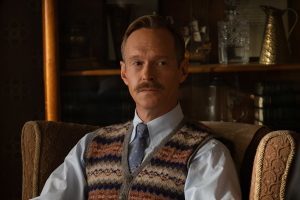
Frequently absent father Stanley Dwight (Steven Mackintosh) missed out on much of his superstar son’s upbringing as depicted in the musical new biopic, “Rocketman.” Photo courtesy of Paramount Pictures.
However, as is the case with anyone who practices conscious creation, our reasons are our own, and, frankly, they’re no one else’s business. Many of us may even engage in this process without being aware of doing so, as could well be the case here. Nevertheless, given that this discipline makes any potential outcome possible, we can use it for materializing wide-ranging results, including everything from exultant joy to the pit of despair. And, based on what happened in Elton’s life, he would appear to have experienced both ends of the spectrum.
One might ask, “What would be the value in engaging in such extremes?” Again, the reasons are each our own, but, in many cases, they have to do with learning particular life lessons that aid in our overall personal growth and development. For instance, in becoming accomplished as a composer of music that reflects many different moods, perhaps Elton needed to experience them all firsthand in order to identify with them, to provide himself with the emotional inspiration needed for translating these feelings into finished melodies. Indeed, would he have been able to write the music for such melancholic pieces as “Sorry Seems to Be the Hardest Word” or “Candle in the Wind” had he not felt the sadness associated with the emotions behind these works? Likewise, could he have composed an uplifting, toe-tapping hit like “I’m Still Standing” had he not gone through personal travails and managed to triumphantly survive them?
This notion is important not only for examining his body of work, but it’s also a crucial narrative device employed to carry the story in the film. In many ways, “Rocketman” is actually a movie musical that tells Elton’s life story through his many diverse compositions, the pieces strategically interspersed to mirror the events and moods he experienced over time. In that regard, this truly is an example of art imitating life, in large part because that life arises from the metaphysical artist within us, the portion of our being that creates with the brush strokes of our beliefs onto the rich and colorful canvas of existence.

Self-serving manager/promoter John Reid (Richard Madden, right) frequently ran afoul of music industry professionals like Dick James (Stephen Graham, center) and even his own client and life partner, Elton John (Taron Egerton, left), as seen in “Rocketman.” Photo courtesy of Paramount Pictures.
Elton’s story also inspires us by showing how we can use our personal creative power to break through the perceived limitations that hold us back from living our destiny. The controlling nature of Elton’s parents, for example, no doubt helps to explain his reserved nature while growing up. Out of fear of ridicule, he consequently retreated within himself, bottling up his considerable talent for years. Those abilities remained dormant, just waiting for the right moment to be liberated. And, when he finally gave himself permission – thanks to Ivy’s encouragement and the impetus of his own beliefs – to let those talents out, they came rushing forth in a torrent of creativity and flamboyancy. With his vision thus unleashed, he was free to let it take him places that he may have once thought unimaginable – and to bring him success beyond his wildest dreams.
That creative liberation spilled over into areas of his life other than his music. It made its presence felt in his personal life, particularly in the area of his sexuality. Even though he struggled for years to publicly acknowledge his true orientation – something that many gay men and women of the time wrestled with – he nonetheless allowed himself to act on his feelings and explore what they could offer him. This was not an easy feat in light of the constant chiding he experienced about the prospect, even into young adulthood, including by those who supposedly loved and cared about him. (His mother, for example, claimed she knew he was gay from the time he was a child but never encouraged him to act on it for fear that he would end up leading a lonely life and never be loved “properly.”) And, despite Elton’s admission during his therapy sessions to being a sexual compulsive, he still overcame the fear-based belief limitations that had held him back from being himself and subsequently finding true love (something, by the way, that came his way after getting clean, Sheila’s caustic cautions notwithstanding).
Through his many experiences, Elton also learned the power of co-creation, the act of collaborating with kindred spirits to birth wondrous manifestations. This is best seen in his work with his songwriting partner Bernie. It’s also apparent in his joint ventures with other musicians, such as John Lennon and Kiki Dee (Rachel Muldoon), with whom he had a huge hit in the Motown-esque duet “Don’t Go Breaking My Heart” in 1976. Indeed, it’s truly amazing what we can achieve when we’re all on the same page.

Ever flamboyant, pop icon Elton John (Taron Egerton) led a lavish lifestyle during his meteoric rise to stardom as seen in “Rocketman.” Photo courtesy of Paramount Pictures.
Thanks to our remarkable manifestation powers, creativity is a force that’s ultimately difficult to contain. When fueled by our beliefs (especially those that are heartfelt and clearly focused), the process can yield results that exceed expectations, no matter what the milieu of expression and even when it seems we’ve passed the point of no return. Elton John’s life story shows us this and has a rollicking good time doing so. Let’s hope we have the wits to jump on our own bandwagon and do the same for ourselves.
“Rocketman” wins big on every front. Director Dexter Fletcher’s lavish biopic hits all the right notes from start to finish. Its inventive song-based approach to this character study adds punch to the storyline, playing like an old-style musical, one that actually works in a contemporary cinematic landscape largely devoid of this genre due to stale or forced releases (that’s saying a lot considering my general dislike of this genre). But, then, that’s been made possible by the film’s carefully chosen song list, one that contains many recognizable, eminently likable tunes (it’s hard to believe that one artist wrote so many classic works). These strengths are further enhanced by a superb production design, featuring sets and costumes whose assignments had to have been dreams come true for the professionals who created them.
Of course, none of this would have worked were it not for the positively outstanding performance of Taron Egerton, an Oscar-worthy portrayal if there ever were one. The rising star may well have cemented his future with this role, disappearing into the character so much that it even convinced his real world counterpart that he was watching himself on the screen. In addition to his portrayal of the legendary rocker, Egerton does all his own dancing and singing, sounding almost indistinguishable from the protagonist himself. This is a truly magnificent performance.
It should come as no surprise that “Rocketman” has drawn more than its share of inevitable comparisons to “Bohemian Rhapsody” (2018), the Academy Award-winning biography of pop star Freddie Mercury, the longtime front man for the rock band Queen. True, both films tell the life stories of famous pop musicians who shared many traits in common, including sexual orientation, substance abuse and their manager. True, both pictures follow their meteoric rise during the ʼ70s and ʼ80s. And true, both movies feature the involvement of filmmaker Fletcher (even though his contributions to “Bohemian Rhapsody” weren’t widely publicized). However, that’s where the similarities end. The storytelling approach used in this film, for example, is completely different from its cinematic cousin. And, obviously, the story itself is all its own. While it’s tempting to see the parallels between these two pictures, in all fairness, viewers should not think of them as cookie-cutter copies of one another; that’s simply not accurate.
In the end, the life we create truly is a sum of all of its parts, no matter how seemingly incongruous and implausible they might initially appear. Because of that, we should take nothing for granted, for we may not always know what’s behind what shows up in our existence, regardless of whether we purposely drew such elements to us or whether they strike us as random, out of character or unexpected. Those elements could well combine to bring us what we secretly (or perhaps even unknowingly) desire most. Such circumstances truly could enable us to rocket to success. Just ask Elton John.
Copyright © 2019, by Brent Marchant. All rights reserved.
The post ‘Rocketman’ celebrates creativity unleashed appeared first on Brent Marchant.
June 10, 2019
‘The World Before Your Feet’ explores fulfillment for its own sake
“The World Before Your Feet” (2018). Cast: Matt Green. Director: Jeremy Workman. Web site. Trailer.
Mountaineer George Mallory became famous (although some would say infamous) for three little words he uttered to a New York Times reporter in 1923 when describing his multiple attempts to ascend Mt. Everest, the world’s highest peak – “Because it’s there.” It’s an expression that’s become virtually synonymous with embarking on a daunting endeavor simply for its own sake. Such undertakings are truly impressive, even if they’re not for everyone. Indeed, where would the spirit of human adventure be were it not for this kind of attitude? So it’s been for an intrepid urban hiker who undertook the challenge of walking all 8,000+ miles of roads, paths and bridges in New York’s five boroughs, a journey gorgeously chronicled in “The World Before Your Feet,” available on DVD and video on demand.
When someone attempts the previously untried, especially when it’s of an awe-inspiring magnitude, onlookers may think the adventurer inspiring or crazy. Accomplishing such a never-before-achieved feat is extraordinary, no matter how one ultimately views it. But the lingering question associated with such a venture still remains, “Why?” That’s especially true when the endeavor requires a radical alteration of one’s lifestyle and priorities. However, for former civil engineer Matt Green, the effort has truly been a labor of love.
Over the course of six years, filmmaker Jeremy Workman followed Green on his ambitious odyssey. Through it all, the director filmed many miles of his subject’s travels. Shot during all four seasons in all five boroughs, Workman captured beautiful images of one of the world’s greatest cities, including many that seemingly defy countless preconceptions held about New York. And, as Green’s journey was being documented, he further chronicled his effort by taking innumerable photos of his adventures, posting them along with his thoughts and impressions in an ongoing blog.

Former engineer Matt Green has made it his mission to walk all 8,000+ miles of New York’s streets, paths and bridges as chronicled in the new documentary “The World Before Your Feet,” available on DVD and video on demand. Photo courtesy of Greenwich Entertainment.
As enterprising as this project might seem, in some ways it was nothing new to the inner city wanderer. Prior to taking on this task, Green walked across the U.S. from Rockaway Beach, NY to Rockaway Beach, OR. In both of these ventures, he learned to live simply, retaining only the most basic of possessions and freely accepting help whenever it was offered. In his New York journey, for example, since he was not gainfully employed, he kept a roof over his head by looking after friends’ homes, cat sitting or sleeping on the couches of those who generously offered him accommodations.
As Green made his way throughout New York, he found his journey was not only one of touring the city, but also one of wondrous discovery. Having time to live without the burden of most of the everyday obligations we all feel we must address has given him an opportunity to notice the little things that make up the city he calls home. He has been able to gain an appreciation for the elements that constitute Gotham that many of us obliviously overlook. It’s also enabled him to focus on subjects that he’s found personally intriguing, from the quirky to the sublime. For example, he’s paid particularly close attention to things like New York’s surprisingly diverse plant life, from trees to flowers to fruits and vegetables growing wild in a diverse array of community and public gardens. He’s also documented considerable information and images about the five boroughs’ “churchagogues” (former synagogues that have now become churches or other houses of worship); New York’s many 9/11 memorials, some official, some makeshift, all stirring and heartfelt; and the city’s vast selection of hair and beauty salons, especially those that somehow manage to slip the letter “z” into their names.
More than that, though, the journey has helped Green discover much about himself, something that many of us seldom take the time to assess and that he didn’t do as often as he might have when he was living a typical professional middle class existence. However, having been seriously injured in a bicycle accident before he began his journeys and living through the ordeal of a brother who experienced a severe stroke at a young age, Green realized that tomorrow isn’t promised. And, from that, he concluded he didn’t want his life to pass him by without taking the time to get to know himself better, something that the time afforded by his cross-country and New York journeys enabled him to do.
It was a decision that required him to make major adjustments in his life, such as breaking off relationships that he couldn’t sustain and divesting himself of nearly all of his belongings. But, for him, it was worth it. He learned that he could live comfortably and contentedly without the shackles that previously bound him (and that, quite frankly, bind most of us). The liberating effects have been more than worth the trade-offs, a consideration that may deserve a look for those of us who are restless or discontented and believe that there might be other possibilities for the way we live our lives. The sheer joy that Green gets from doing what we wants, when he wants and on his terms would seem to bear that out.

Sanitation workers (center and right) are among the many diverse people urban hiker Matt Green (left) has encountered during his journey to walk all 8,000+ miles of New York’s streets, paths and bridges as seen in the documentary “The World Before Your Feet.” Photo courtesy of Greenwich Entertainment.
There’s a commonly held notion that likely began in the philosophical community but that has since found its way into everyday discourse – the idea that “everything happens for a reason.” To many, though, that might sound rather implausible in cases like this: What’s really to be gained from walking every mile of New York’s streets? To be sure, the true purpose behind such ventures could easily be well hidden from view, even from the individuals who have undertaken them. In all likelihood, however, there is a motivation, intent or reason driving the endeavors; the trick is discovering what it is. And a good place to start looking is with one’s beliefs, for they provide the foundation that drives the conscious creation process, the philosophy that maintains we draw upon this intangible resource for shaping the reality we experience.
There are a number of possible belief-based explanations for such undertakings, even if their origins aren’t readily apparent or discernible either by casual onlookers or those who are bringing them into being. Those who undertake these projects may not have heard of the conscious creation process, either. But that doesn’t mean that the underlying beliefs birthing these manifestation are absent.
From information that’s revealed in the film, Green admits that he isn’t completely aware of why he’s doing what he’s doing but adds that he feels compelled to do it. Whatever the underlying motivation, though, it’s obvious he has a strong sense of self, something that seems to have long been present, even before he began his urban adventure. After the health crises that he and his brother experienced, for example, he obviously had the presence of mind to recognize that life isn’t promised, that it can evaporate before our eyes, a realization that led to a belief in the need to live our lives while the opportunity is available. That kind of personal awakening often leads individuals to undertake projects for their own sake – like walking every mile of the streets of New York.
As noted above, this has enabled the self-discovery that Green has come to value so much. And that’s something fairly significant in itself, something many of us never take the time to investigate. So, to the skeptics who wonder what the purpose behind this venture might be, this alone is a pretty important reason.

Big city wanderer Matt Green (left) and director Jeremy Workman (right) have collaborated to produce a beautiful homage to the street life of New York’s five boroughs as seen in “The World Before Your Feet.” Photo courtesy of Greenwich Entertainment.
But this is by no means the only possible explanation. It could also be seen as an exercise in stretching one’s creative capabilities, of pushing through limitations to achieve what might have previously been thought to be unattainable. It’s about finding ways to make seemingly impossible dreams happen when we set our mind to it. It’s about being faithful to honoring our own most heartfelt intentions, making it possible to become our truest, most authentic selves and being able to rightfully claim that we’re living our lives with personal integrity.
The foregoing considerations are examples of the conscious creation principle of value fulfillment, the concept whereby we use the process to become who we were meant to be for the betterment of our selves and those around us. In Green’s case, his venture is an inspiration to others, whether they’re replicating what he’s doing or attempting something of a comparable scale. What’s more, the findings he’s amassed through his odyssey represent a wealth of information that no one else has probably compiled, something that may not have happened without his efforts. Even if this material isn’t open to commercialization or is interesting only to a limited few, he’s still fulfilled a beneficial purpose that has previously gone unaddressed. Again, there’s much to be said for this, and we can thank Matt for his accomplishments, no matter how eccentric or unconventional.
This stunningly beautiful homage to an incredible city, an inspiring individual and the value of living life in the moment entertains while it enlightens, taking viewers on an odyssey of more than just the many striking attractions that Gotham has to offer. It also surveys the beauty within each of us, the parts of ourselves that we seldom see but that are just as magnificent as any surface trappings. For his part, Matt Green got a glimpse of that and liked what he saw. At first glance, one might be tempted to say that that’s a nice little gift to himself, a benefit of being fortunate enough to have the time to figure out how to live unburdened by the hindrances of modern-day life. But he’s not the only one to benefit from this; by sharing his experience, he’s shown us how we can all do the same for ourselves if we have the will and character to choose to do so.
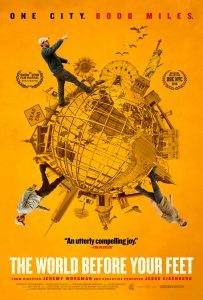
Some may say there’s no commercial value in taking on ventures like the one that Matt Green has tackled. But, as his experience has revealed, must that always be the case with anything that we undertake? Sometimes the sheer enjoyment value of pursuing such personally meaningful quests is far greater than anything that money can buy, and, thankfully, there are still those among us out there who haven’t lost sight of that.
Copyright © 2019, by Brent Marchant. All rights reserved.
The post ‘The World Before Your Feet’ explores fulfillment for its own sake appeared first on Brent Marchant.
June 6, 2019
This Week in Movies with Meaning
Reviews of “The Tomorrow Man” and “The World Before Your Feet,” as well as a cinematic responsibility rant, are all in the latest Movies with Meaning post on the web site of The Good Media Network, available by clicking here.
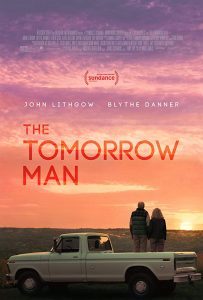



The post This Week in Movies with Meaning appeared first on Brent Marchant.
June 4, 2019
‘The Tomorrow Man’ urges us to live in the moment
“The Tomorrow Man” (2019). Cast: John Lithgow, Blythe Danner, Derek Cecil, Katie Aselton, Sophie Thatcher, Eve Harlow, Wendy Makkena, Isabelle Boni, Naveen Havannavar, John Sindoni. Director: Noble Lincoln Jones. Screenplay: Noble Lincoln Jones. Web site. Trailer.
There’s nothing wrong with looking ahead – unless, of course, it becomes so compulsive that it keeps us from enjoying (or perhaps even recognizing) what’s going on around us – the present moment in which we dwell. It’s somewhat akin to being more worried about taking a smart phone photo of a significant event than the event itself. Yet, as comical as that may sound, all too often our focus is misplaced, myopically cast on the erroneous priority. We can miss a lot by doing that, something we could end up regretting if we do it for too long and let what truly matters go unrecognized as time evaporates away from us. Such is the potential pitfall faced by a worrisome, somewhat paranoid senior in the new romantic comedy-drama, “The Tomorrow Man.”
Ed Hemsler (John Lithgow) worries incessantly about the future. The retired sixtysomething former systems analyst lives in a small town that could be virtually anywhere in the US, where everyday solid citizens dutifully go about their business believing that nothing will ever change as life goes on. But not Ed. He spends virtually all of his time – and money – prepping for some kind of looming but undefined disaster, be it war, economic collapse, martial law or Donald Trump’s re-election. He readies for this enigmatic indeterminate catastrophe by stockpiling everything from food to toilet paper to condoms in a secret storage room in his house, one whose existence he guards as if it’s Ft. Knox.
Ed’s preoccupation makes him something of a loner. The senior divorcee separated from his ex-wife years ago, and he has little (and mostly one-sided) contact with his son, Brian (Derek Cecil). Because of his relentless pontificating about the need to be prepared, as well as his incessant conspiracy theory rants, nobody really wants to talk to him except for a handful of kindred spirits on the internet. He doesn’t seem to mind too much, but he also does little to change his circumstances – that is, until he goes shopping at the local supermarket one day.
While picking up items for his everyday needs and supplementing his storage room’s supplies, Ed spies a spry but reserved fellow senior, Ronnie Meisner (Blythe Danner). He’s instantly smitten. Yet acting on an attraction to someone else is decidedly out of character for Ed, and his awkward initial attempts at getting to know her fall flat. Nevertheless he finds something special about Ronnie, and, in time, she discovers the same about him. And so, despite their cumbersome beginning, before long, the seemingly mismatched duo is an item.

Seniors Ed Hemsler (John Lithgow, background) and Ronnie Meisner (Blythe Danner, foreground) find love at an unexpected time in their lives in the delightfully quirky new romantic comedy, “The Tomorrow Man.” Photo courtesy of Bleecker Street.
As their relationship evolves, however, not everything proceeds smoothly. Despite his feelings for Ronnie, Ed never lets go of his survivalist prepping. At the same time, Ronnie struggles with baggage of her own, issues that conceal a dark secret that she’s reluctant to share with anyone, including Ed. Their respective concerns hang over each of them (and one another) like pesky little dark clouds that intrude on what should be a happy time in their lives. In essence, Ed frets about a future that hasn’t happened (and may never do so), while Ronnie struggles to let go of a painful past that obstinately persists despite any efforts to shed it.
One can’t help but hope that this otherwise-seemingly happy couple will figure out a way to make things work. But, no matter what they do, Ed and Ronnie don’t seem to be able to get out of their own way. Can they succeed in their efforts? And will they do so before it’s too late to do anything about their circumstances? With the clock ticking and uncertainty always lurking around the corner, there may be fewer and fewer opportunities to rectify their situation. Will they choose happiness or succumb to inevitable disappointment?
As in virtually any situation, the choice rests with Ed and Ronnie, and those choices are governed by their respective and joint beliefs, the building blocks of the conscious creation process, the philosophy that maintains we draw upon these resources to manifest the reality we experience. And, because our beliefs can take any form we desire, we can essentially use them to create whatever we want. The trick in understanding this, though, is that we’re the ones who choose which of those beliefs to embrace, so it’s thus up to us as far as what we experience.

Senior Ronnie Meisner (Blythe Danner) dresses up for a date for the first time in years in director Noble Lincoln Jones’s debut feature, “The Tomorrow Man.” Photo courtesy of Bleecker Street.
For Ed and Ronnie, their respective beliefs are governed by elements that make their alteration challenging. As noted previously, Ed is preoccupied with the future, while Ronnie is tied to her past. In each case, they’re invested in beliefs associated with time frames over which they have no control. Ed’s future has not arrived and, consequently, could end up taking myriad forms, none of which can be definitively predicted in advance. Meanwhile, Ronnie’s past is behind her, a done deal over which she has no say over how it unfolded, regardless of how unpalatable or unpleasant she may find it. So that leaves only one temporal window over which they (or any of us, for that matter) have any meaningful control – the present.
Seasoned conscious creators understand that the present is the point of power, because it’s the only time frame over which we can shape its character and qualities. The concept of “living in the moment” is thus a principle we’d be wise to adopt.
However, as much as we may like the sound of this idea, many of us find it difficult to put it into action, and that’s largely because of the persistence of our beliefs. This in itself shows how powerful they are and how doggedly they can hang on, despite efforts to change them, even when we know that the ones we’re embracing aren’t necessarily in our best interests.
This casts a bright light on the need to get a firm handle on the precise nature of our beliefs. This involves looking inward and taking stock of who we are and what we really believe. Some of us may not succeed at this out of fright at what we might find, what we could stand to lose or the uncertainty of having to venture into uncharted territory. Nevertheless, if we want to truly be effective as conscious creators, we must be courageous enough to tap into our authentic selves to determine exactly what’s driving our manifestations, how we might want to change them if needed and what it takes to allow our personal integrity to shine through into our materializations.
Where Ed and Ronnie are concerned, for example, they’re at the age where they’re each staring their own mortality squarely in the face. That’s a scary prospect for those who haven’t considered it, and denial is a coping mechanism commonly employed for evading it. But is this strategy helpful in the end? If Ed endlessly plans for the future, then maybe he’s lulled himself into believing that his life will also carry on in perpetuity, that his constant vigilance against potential calamities will somehow stave off the one that ultimately scares him most. Similarly, if Ronnie believes she can bury herself in the memories of her past – no matter how distressing some of them may have been – then perhaps that will obscure her appearance at the time when the Grim Reaper comes knocking at her door.

The sunset years can be so bright that they really do require shades as seniors Ronnie Meisner (Blythe Danner, foreground) and Ed Hemsler (John Lithgow, background) learn for themselves in “The Tomorrow Man.” Photo courtesy of Bleecker Street.
Realistically speaking, however, do these really sound like viable solutions? Wouldn’t it be preferable to channel our beliefs into more fruitful pursuits, ones that give us joy and allow us to relish whatever time we have left, to truly live in the moment? Such options are available, but it’s up to us to embrace beliefs that genuinely make them possible. Indeed, the choice is ours.
This delightfully quirky senior romance tale charms from beginning to end. Its deceptively subtle, surprisingly insightful narrative gives viewers much to think about, especially those of us who are a little further along our life paths. Its bittersweet story line presents a realistic view of romance later in life, particularly for partners who cling to eccentricities they cannot shed but who at least have one other to see their way through the tenuous and painful process. While not all elements of the film or the characters work, and even though some aspects are a little too formula for their own good, the picture nevertheless has more than its share of funny twists and turns, as well as superb performances by John Lithgow and Blythe Danner as the unlikely consorts. Director Noble Lincoln Jones’s beautifully shot debut feature serves up an excellent example of living in the moment, without worrying about a past that has come and gone and a future that has yet to arrive. Think of this as a geriatric version of “Seeking a Friend for the End of the World” (2012) but without the rampant silliness, and you’ve got an idea what this release is all about.
“The Tomorrow Man” is currently playing in limited release in theaters specializing in independent and arthouse cinema. Given the upcoming crush of summer blockbusters, this offering may quickly be overwhelmed by the competition and swept out of moviehouses, so act fast if you hope to catch this one on the big screen.

It would be foolhardy to say we should never consider the contingencies available to us. Indeed, Plan B has its place. But, when we engage in the kind of preparation that leads us to making so many plans that we run out of letters of the alphabet, maybe we need to step back and examine what we’re doing – and why. When planning our life becomes more important than living it, something is definitely amiss. The cautionary tale of “The Tomorrow Man” puts this on display for all of us to see, reminding us to look up once in a while and enjoy the view – while it lasts.
Copyright © 2019, by Brent Marchant. All rights reserved.
The post ‘The Tomorrow Man’ urges us to live in the moment appeared first on Brent Marchant.
Tour Gotham on The Cinema Scribe
Tune in for the latest Cinema Scribe segment on Bring Me 2 Life Radio, Tuesday, June 4, at 2 pm ET, available by clicking here. And, if you don’t hear it live, catch it later on demand!


The post Tour Gotham on The Cinema Scribe appeared first on Brent Marchant.
May 31, 2019
Wantonly Disgusting: A Film Commentary
As most of my readers are aware, I rarely write negative film analyses. The point of this blog is to inform followers about movies that offer inspiring examples of enlightening concepts that we can use to help ourselves in leading more fulfilling lives, particularly where the use of conscious creation/law of attraction principles is concerned. However, every so often, a picture comes along that I feel compelled to write about for reasons other than those stated above. Those instances nearly always involve releases that I find notably disturbing – or, in this case, wantonly disgusting – offerings that, to me, represent deplorable cinematic trends or genres. And that’s what brings me to “John Wick: Chapter 3 – Parabellum” (web site, trailer).
If “pornography” is truly defined as “having no redeeming social value,” then this positively awful release would most certainly qualify. The film’s simplistic, often-improbable, virtually nonexistent plot, endless fight sequences that quickly become repetitive and boring, relentlessly gratuitous violence, and monotone acting by the protagonist combine to transform what should be a compelling action thriller into a tasteless snooze that had me checking my watch more than a few times. With the exception of a handful of intriguing supporting performances (Angelica Huston, Laurence Fishburne, Halle Berry, Ian McShane, Lance Reddick) and the occasional infusion of humor, this one has nothing (and I do mean nothing) else to offer.
Given the perspective from which I write, I’ll admit that I look for something more meaningful than just a captivating story. I prefer offerings that have something to say while spinning a good yarn. But, contrary to some misconceptions of my work, I’m not opposed to entertaining cinema for its own sake, and that includes action-adventure sagas, such as a number of the Marvel Universe releases and the most recent installment in the “Mission Impossible” franchise, which made it onto my Top 10 list for 2018.
There’s also a misconception that, because I write about cinema from what I’ll loosely call a New Age viewpoint, I’m completely opposed to action and violence in films. That’s not true, either, a position I have explained often in my writing and radio interviews. I have no reservations about their inclusion when they’re featured in films with compelling stories and presented in context, not gratuitously. For instance, I’m a big fan of the James Bond franchise and the aforementioned “Mission Impossible” series. I delighted in the over-the-top humorously macabre “Kingsman” debut (2014) and both “Deadpool” installments (2016, 2018). I even had no problem with the excessive carnage in “Watchmen” (2009), an offering that very consciously, cleverly and intentionally used this plot device to make a point about it. In all of these cases, there was a purpose for the action and violence shown on screen, they were done so in context, and they integrally helped to make their films work. To me, that’s responsible, capable filmmaking.
However, in the latest John Wick offering, these elements are clearly out of control, going on endlessly for their own sake with a woefully weak plot to string them together. There seems to be more interest in seeing how high the body count can go without regard for telling a worthwhile story. And it lacks the humor and relevance of other pictures that employ these qualities to help reinforce their missions.

But what troubles me most is the callous, unfeeling approach that’s used here. In many sequences, the narrative consists of little more than carrying out a brutal killing and then moving on to the next in a perpetual cycle of rinse and repeat. And, to make matters worse, viewers gawk in amazement at such butchery, finding the screen action “cool.”
I find that reaction utterly appalling. I dare anyone to explain to me how such nonstop cold-blooded murder is “cool” in the slightest. Indeed, if we’re ever to see anything change in our world, we’ve got to stop glorifying such horrendous acts, even in our entertainment vehicles. As a Chicagoan who has lived through years of senseless street killings, like many of my fellow Windy City residents, I have found such acts wholly inexcusable, yet the kind of deplorable violence that’s celebrated in a movie like “John Wick” is … “cool?” Forgive me, but that kind of logic completely escapes me, even if it is “just fiction.”
In preparing this commentary, I’ve considered the viewpoints of the fans of this film. Many have contended that there was tremendous artistry and skill put into creating and filming the fight sequences, and I don’t doubt that. But what good is that if the material itself is, essentially, intrinsically pointless? Moreover, many fans have likened the picture to exquisitely choreographed martial arts classics like Bruce Lee’s “Enter the Dragon” (1973). However, despite such lofty but ultimately superficial comparisons, this offering lacks the soul of its predecessors, coming across as cold, emotionless and unconcerned for its characters and the message it’s sending to audiences.
In my view, I find myself having to agree with those few courageous dissenting critics who have, for all intents and purposes, essentially claimed that “there’s no there there”. Most of them have said that this installment plays like a video game version of the movies in this franchise, and I’d agree that they’re spot-on in their analyses. Just as video games heartlessly celebrate the deaths of their characters, so, too, does this film. And, as there seems to be some indication that some impressionable gamers may be unable to distinguish between video game kills and real life deaths, maybe filmmakers should take a lesson from that and consider what they’re putting out on the world’s movie screens. It seems to me to be the responsible thing to do.
Unless you have a penchant for watching senseless, recurring violence run amok, save your money where this one is concerned. And, if you’re like me and take issue with the message pictures like this are sending, please share this rant with others. If enough readers protest against such wantonly disgusting releases, maybe we can get the movie industry to rethink what it’s selling to the public. The #MeToo movement has already shown that such reform efforts can have an impact; maybe that result is transferable to one like this as well. The well-being of our society’s future could depend on it.
Copyright © 2019, by Brent Marchant. All rights reserved.
The post Wantonly Disgusting: A Film Commentary appeared first on Brent Marchant.
May 28, 2019
Documentary Week on Movies with Meaning
Reviews of “Meeting Gorbachev,” “Hail Satan?” and “Ask Dr. Ruth” are all in the latest Movies with Meaning post on the web site of The Good Media Network, available by clicking here.
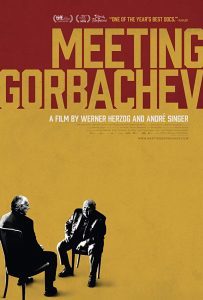
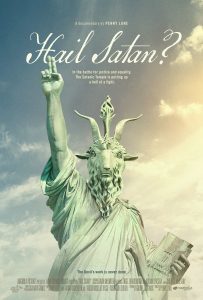


The post Documentary Week on Movies with Meaning appeared first on Brent Marchant.
May 26, 2019
‘Ask Dr. Ruth’ lovingly profiles a sexual revolutionary
“Ask Dr. Ruth” (2019). Cast: Interviews: Dr. Ruth Westheimer, Miriam Westheimer, Joel Westheimer, Jonathan Capehart, Betty Elam. Archive Footage: Johnny Carson, Arsenio Hall, David Letterman, Joan Rivers, Diane Sawyer, Phil Donahue, Regis Philbin, Bo Jackson, Fred Westheimer, Helen Singer Kaplan. Director: Ryan White. Web site. Trailer.
Were it not for sex, none of us would be here. Yet it’s amazing how, until comparatively recently, many of us have been reluctant or embarrassed to openly discuss something so fundamental to our nature and very being. No matter what the reason behind this, the hesitant among us long avoided the subject, almost pretending as if it somehow didn’t exist. But, given the magnitude of what’s involved in sexuality – on so many different fronts – it’s often been to our detriment to evade talking about it. This is why it has been so valuable to have someone come along who has been willing and courageous enough to help lead us out of the erotic darkness, to bring sex above board and out into the open for plainspoken but informed conversation, as seen in the new biographical documentary, “Ask Dr. Ruth.”
The national discussion about sex took a dramatic leap forward in 1980 with the premiere of Sexually Speaking on New York’s WYNY-FM radio. The public affairs broadcast, which was launched primarily to fulfill the station’s FCC licensing requirements, aired Sundays at midnight, a time slot typically allocated to low-ratings programming like this. But, much to everyone’s surprise, the show became a big hit, thanks primarily to its delightfully charismatic host, sex therapist Dr. Ruth Westheimer.
The charming, diminutive Dr. Ruth had never hosted a radio show before. However, her positive demeanor, practical, no-nonsense advice, and delightful German accent captivated listening audiences. Before long, she was hosting WYNY’s most popular program. And, over the next several years, she became a national media sensation, hosting syndicated radio and TV shows and making appearances on late night talk shows, game shows and other network programs, as well as in made-for-TV movies and commercials. She almost single-handedly made it possible to speak openly, publicly and frankly about sex in the media while simultaneously transforming herself into a cottage industry that proliferated and has persisted to this day.

At 90 years young, sex therapist Dr. Ruth Westheimer keeps a full schedule as a writer, lecturer and media celebrity, as depicted in the new biographical documentary, “Ask Dr. Ruth.” Photo by Austin Hargrave, courtesy of Hulu Originals and Magnolia Pictures.
In “Ask Dr. Ruth,” director Ryan White lovingly profiles his munchkin-esque subject, revealing how this unlikely 90-year-old sexual guru rose to prominence and made such a significant mark on the nation’s outlook on a once-taboo subject. He shows how she became a notable figure in the sex therapy arena, as well as one of the most recognizable media personalities of the past 30+ years. But what’s perhaps most interesting is the filmmaker’s depiction of how she got there, a storied journey that took her through many trials, tribulations and escapades far removed from her roots.
Born Karola Ruth Siegel to Orthodox German Jewish parents in 1928, Westheimer grew up in Frankfurt. However, with the rise of the Third Reich and antisemitism over the next decade, her family’s future became increasingly uncertain. In hopes that she would be safe, Westheimer’s parents sent her to Switzerland in 1939 as part of the Kindertransport program, an effort aimed at protecting Jewish children by housing them in orphanages. But, when the young Karola left her homeland, it was the last time she would see her parents, who would eventually become victims of the Holocaust.
When World War II ended, Westheimer emigrated to British-controlled Palestine, where she joined the Haganah, a Jewish paramilitary organization, training as a scout and sniper. She says she never killed anyone but became a sharp shooter who never missed the target. But the violence in the region nearly took a toll on her in 1948, when the explosion of a shell nearly cost her both of her feet.
After nursing herself back to health, Ruth relocated to France in 1950 with her first husband, a med school student. She studied and then taught psychology at the University of Paris, the beginning of a long and impressive educational path. The marriage didn’t last, however, her husband returning to Israel. But Westheimer was not alone for long, marrying her second husband when she became pregnant with her first child, Miriam. The couple emigrated to the US in 1956 for a new beginning, but this marriage did not last, either. Ruth soon found herself a single parent in New York, seeking to make ends meet while earning her master’s in sociology from The New School for Social Research.

Never a stranger to a microphone, sex therapist Dr. Ruth Westheimer routinely doles out advice to captivated listeners, as seen in director Ryan White’s loving tribute to the guru of eroticism, “Ask Dr. Ruth.” Photo courtesy of Hulu Originals and Magnolia Pictures.
After two failed marriages, Ruth finally found the love of her life, Fred Westheimer, whom she married in 1961. The couple became parents of a second child, Joel, in 1964, moving to an apartment in the city’s Washington Heights neighborhood, where she still lives today. While raising her children, Ruth worked toward her doctorate in education, a degree she earned from Columbia University in 1970.
Ruth took a job at Planned Parenthood after graduation, a position that sparked her interest in human sexuality. It served as a springboard to post-doctoral study in the subject, working as a researcher with Helen Singer Kaplan at New York-Presbyterian Hospital. This background thus laid the foundation for what was to come when WYNY community affairs manager Betty Elam approached Westheimer and offered her the opportunity to host Sexually Speaking. And the rest, as they say, is history.
As Westheimer’s new career developed, she became more than just the host of a show about titillating dirty talk. She was a committed sexual educator who spoke candidly about subjects rarely if ever before broached in high-profile public settings. Her advice helped to dispel myths and offer comfort and guidance to those who lived lives outside the sexual mainstream, while giving individuals of all orientations useful and imaginative ideas on how to spice up their bedroom activities. In addition to her media appearances, Ruth became an accomplished and prolific author, producing a variety of books and articles, as well as a university lecturer. She also became a staunchly vocal advocate for research during the early days of the AIDS crisis, addressing the subject head-on and professionally at a time when others downplayed it, disparaged its victims and even made fun of the devastating illness.
Through it all, Ruth truly evolved as a sexual revolutionary, unlikely though it might seem. Given the tremendous success she’s attained, it’s apparent that Westheimer is quite proficient in the practice of conscious creation, the philosophy that maintains we manifest the reality we experience through the power of our thoughts, beliefs and intents. And, even if she’s never heard of this metaphysical doctrine, it’s obvious she’s well versed in its principles. Her expertise as a therapist, author, educator, and radio and TV host is a testament to this.

At home in New York, sex therapist Dr. Ruth Westheimer enjoys life from the same Washington Heights apartment she’s lived in for decades, one of the venues shown in the new biographical documentary, “Ask Dr. Ruth.” Photo courtesy of Hulu Originals and Magnolia Pictures.
Of course, critics would contend that, if she was so adept at creating such success, then why did she endure the hardships of her youth? That’s a legitimate question, but we can never really know why others manifest what they do, since their reasons are their own, and it’s not our place to question their motives. However, surely there are purposes behind such creations, even if they’re not readily apparent.
In many instances, seemingly questionable materializations often are related to learning particular life lessons. These ordeals can be difficult to go through, but their impact can be substantial, imprinting their significance deeply within our being, perhaps alerting us to the need for not repeating them and/or learning how to avoid them again in the future.
In other cases, certain experiences can help to groom us for what is to come later in our lives. For example, Ruth’s all-too-familiar awareness of what happened to Europe’s Jewish population during World War II helped prepare her for the rampant and hostile discrimination, bigotry and intolerance inflicted upon AIDS sufferers during the early days of the epidemic. Having lived through somewhat comparable circumstances, she became quite vocal in countering the arguments of those who called for the quarantining of the sick in camps not unlike those to which Jews and other minorities were corralled as part of Hitler’s “final solution.” Had she not had that experience in her youth, she may not have been able to relate to the indignities inflicted upon AIDS patients – or to speak to the troubling proposals that were raised – as authoritatively as she did as an adult. It also enabled her to become a champion for those seeking research into the causes of, and a cure for, this debilitating and heartbreaking illness.
Then there’s Ruth’s legendary diminutive stature. Standing at a mere 4’ 7”, under most circumstances, she ordinarily might not have been perceived as a force to be reckoned with. However, her slight physique helped make her a fighter, both literally and figuratively. For instance, her limited size made her an ideal candidate for becoming a Haganah recruit, one who could easily shrink into the surroundings, a quality well suited to a scout and sniper. And that experience, in turn, helped galvanize her as a frank, outspoken advocate for her causes and subject matter. It enabled her to push through barriers and command respect for her and her work. So this naturally raises the question, would she have been able to accomplish these tasks if she had grown into a “normal” stature?

Back in Switzerland where she escaped the Nazi encroachment during World War II, Dr. Ruth Westheimer returns to the land that provided the young German Jew sanctuary – and saved her life – during the horrors of the Holocaust, as seen in “Ask Dr. Ruth.” Photo courtesy of Hulu Originals and Magnolia Pictures.
This feistiness also helped to make Ruth a fierce proponent for no-nonsense sex education and advice, something that didn’t always sit well with society’s more conservative elements during the early days of her career. She met with frequent criticism, and one opponent even went so far as to try and initiate a citizen’s arrest against her for allegedly violating public morality standards. Ruth would have none of that, though, stridently maintaining her values and infusing them with hefty doses of personal integrity and informed insights, qualities essential to her effectiveness.
All of which have made it possible for Ruth to live out her value fulfillment, the conscious creation concept associated with being our best, truest selves for the betterment of ourselves and those around us. I’ve written extensively about this subject of late, but that’s been possible thanks to the array of recent film releases (mostly biographies and documentaries) that have profiled individuals and organizations whose lives and actions have embodied this principle. Perhaps their proliferation and popularity are due to a perception that this is an attribute that’s in all too short supply these days, that it’s something desperately needed in our political, social, educational and commercial institutions. Such recent movies have thus provided viewers with excellent examples to emulate, and that’s very much the case here. Ruth’s willingness to take on such a once-controversial subject as human sexuality – and to do so with obviously great joy and enthusiasm – is indicative of value fulfillment in action. We should all be so courageous and spirited in our own quests.
Westheimer’s efforts have radically changed the sexual landscape, with implications that could be far more reaching than any of us is consciously aware. Would legalized same-sex marriage, for example, have come about were it not for the changes in attitude that Dr. Ruth helped to foster? Indeed, many of us may owe her far more than we know.

This endearing tribute lovingly portrays the life and adventures of a beloved expert and educator, charming – and moving – viewers at nearly every turn. It’s gratifying to see a film that honors the work of someone who has done so much good for so many. It paints a colorful portrait of a colorful character, one that’s a sure-fire crowd pleaser. “Ask Dr. Ruth” is currently playing in a limited theatrical run and will be available for streaming on Hulu beginning June 1.
If sex is indeed an essential part of our existence, wouldn’t it make sense for us to know as much about it as we can? As a truly creative force in its own right, sex is something through which we can exercise those imagination muscles we’re all equipped with, not only to make the experience more fulfilling and enjoyable, but also to inspire our overall inventiveness and ingenuity, attributes we can employ to enrich our larger existence and not just our erotic capabilities. Thankfully, we have someone like Dr. Ruth to help launch us into such explorations of deeper awareness, understanding and satisfaction on myriad fronts. And I don’t know about you, but that’s certainly good for me.
Cigarette anyone?
Copyright © 2019, by Brent Marchant. All rights reserved.
The post ‘Ask Dr. Ruth’ lovingly profiles a sexual revolutionary appeared first on Brent Marchant.
May 24, 2019
‘Meeting Gorbachev’ celebrates a pragmatic visionary
“Meeting Gorbachev” (2019). Cast: Interviews: Mikhail Gorbachev, Werner Herzog, Miklós Németh, George Shultz, James Baker, Lech Walesa, Horst Teltschik. Archive Footage: Raisa Gorbachev, Yuri Andropov, Leonid Brezhnev, Konstantin Chernenko, Vladimir Putin, Boris Yeltsin, Ronald Reagan, George H.W. Bush, Margaret Thatcher, Helmut Kohl, Andrei Gromyko. Directors: Werner Herzog and Andre Singer. Screenplay: Werner Herzog. Web site. Trailer.
It’s one thing to be ever-practical when it comes to conducting our affairs, but this approach may sometimes limit our options, outcomes and effectiveness. By contrast, we could adopt a truly visionary view, one that surpasses these shortcomings but that also may be difficult to fulfill due to lack of pragmatism. So it’s quite something when we’re able to fuse both qualities, making it possible to work truly inspired wonders. Such is the approach employed by an accomplished statesman, one whose achievements arguably have not received the recognition they deserve, notions addressed in the engaging new documentary, “Meeting Gorbachev.”
As the 1980s began, almost no one foresaw the significant changes that were to come over the next 10 years. However, as the decade played out, it led to an array of geopolitical shifts that carried on into subsequent years and whose impact has been felt ever since.
Nowhere was this more apparent than in the Soviet Union, a declining superpower that was being propped up largely by its own propaganda. The woeful state of the country was generally not known outside its borders, but Soviet citizens were all too aware of its shortcomings, experiencing its problems, frustrations and inadequacies on a daily basis. A string of aging and ailing leaders – Leonid Brezhnev, Yuri Andropov and Konstantin Chernenko – did little more than keep the seat warm, unable to meet the needs of a population that was tiring of perpetual shortages, rampant ineptitude and runaway corruption.
However, there was one Soviet political figure who saw the handwriting on the wall, one who knew that sweeping reform was desperately needed, one who brought a visionary pragmatism to the table and sought to see it implemented. This little-known figure seemed to come out of nowhere but quickly rose to prominence on the national and international stages, his name becoming synonymous with change in an evolving USSR, Mikhail Gorbachev.
“Meeting Gorbachev” recounts the Soviet leader’s recollections of these events. Director Werner Herzog interviews Gorbachev about his accomplishments – and disappointments – and the impact they’ve had on shaping the world of today. Intercut with these conversations are archive footage of the events themselves, as well as interviews with those who were witnesses to history, including former US Secretaries of State George Shultz and James Baker, former Hungarian Prime Minister Miklós Németh, Solidarity Founder Lech Walesa and former West German foreign affairs advisor Horst Teltschik. This combination paints an intriguing portrait of the film’s central figure.

Director Werner Herzog (left) interviews former Soviet leader Mikhail Gorbachev (right) in the candid new documentary, “Meeting Gorbachev.” Photo courtesy of the Tribeca Film Festival/Getty Images.
From meager beginnings in rural Russia, Gorbachev grew up in the shadow of World War II and the abuses of the Stalinist regime. Life was difficult during those times, conditions that made him acutely aware of the difficulties involved in issues as basic as everyday survival. He drew upon that experience as he moved up through the ranks of the Communist Party, taking a practical approach to his official duties in such areas as agriculture and civil engineering projects.
By the late ʼ70s and early ʼ80s, Gorbachev could see that the Soviet Union was on the brink. The protracted Cold War with the West, a failed occupation of Afghanistan and simmering domestic discontent were placing an increasingly greater strain on the country, all of which could no longer be afforded. Things had to change, and, by the time Gorbachev got his shot at the top slot in 1985, he at last had his opportunity.
In the ensuing years, Gorbachev made a point to reach out to the citizenry to learn what was needed. This led to the formation of his now-famous policies of perestroika (restructuring) and glasnost (openness), doctrines that became immensely popular both at home and abroad. It helped him win over many allies and to amass considerable political capital, assets that would prove exceedingly valuable in 1986, when he faced one of his greatest leadership challenges, the nuclear accident at Chernobyl. This incident marked a turning point in both Gorbachev’s rule and in the history of the Soviet Union.
Chernobyl helped Gorbachev realize the dangers of nuclear technology, not only when it comes to power plants, but also to weapons of mass destruction. He knew that the world could not continue on the course it was on. An out-of-control arms race, he believed, was too great a risk to the future of civilization if it continued unabated. Thus began Gorbachev’s initiatives to reach out to the West, most notably President Ronald Reagan and British Prime Minister Margaret Thatcher, to bring these matters under control.
Not long thereafter, Gorbachev witnessed the rise of democracy movements in the Soviet Union’s satellite states in Eastern Europe, most notably Hungary, Poland and Czechoslovakia. He also watched the Soviet occupation of Afghanistan – a mess he inherited from his predecessors – spiral into a quagmire that was being referred to as “Russia’s Vietnam.” Realizing that he could barely manage what was happening at home, he knew that he could ill afford to take on what was happening outside his borders. These insights prompted him to handle these situations differently from his forbears, taking no action against the Eastern Bloc and withdrawing troops from his southern Islamic neighbor. Thus began a chain of events that led to the dissolution of the Warsaw Pact, the fall of the Berlin Wall and even the reunification of Germany.
Collectively, these changes brought about huge alterations in the geopolitical landscape. But, despite the progress they represented, for some, the changes didn’t unfold far or fast enough. Opportunists thus emerged to invoke their own agendas. In August 1991, a coup d’etat attempt was made to oust Gorbachev while he was vacationing with his family, but loyal supporters squelched the challenge to his authority. However, despite his success in this incident, he also faced secession initiatives launched by a number of Soviet republics, most notably the Baltic states of Lithuania, Latvia and Estonia. It wasn’t long before other republics followed suit, a move that led to the Soviet Union’s dissolution.
Once out of office, Gorbachev devoted much of his time to the establishment of a foundation, lecturing and serving as a political advisor. However, as he observes in the film, there’s a sadness associated with his later years. He’s disappointed that he was unable to complete the work he started, such as increased democratization, bridging the European Community and the Soviet Union, and continuing his work for nuclear disarmament. He’s also saddened that many of his onetime supporters abandoned him once he was no longer in power. Much of his enthusiasm was further sapped by the loss of his wife, Raisa, the love of his life, to leukemia in 1999.
Given these developments, it might be a stretch to call him “a broken man,” but the now-88-year-old has clearly been wounded by what happened to him after such a promising and auspicious start. Nevertheless, in light of how much Gorbachev accomplished, his opinion still carries weight, and we’d be wise to listen to it. He’s concerned about the current state of relations between Russia and the West, fearing the rise of a new Cold War and a new arms race. He sees this as a classic case of not learning from the past, particularly where nuclear armament is concerned. It would indeed be a tragedy if everything he worked for were to be wiped out by the shortsightedness of current leaders.
When one considers how much meaningful change Gorbachev was able to implement, one can’t help but wonder how he did it. But, in examining his means and methods, it’s apparent that he’s quite skilled in the practice of conscious creation, the philosophy that maintains we manifest the reality we experience through the power of our thoughts, beliefs and intents. Even if he’s never heard of it, his track record shows he’s certainly accomplished in its principles.

As noted above, Gorbachev is best described as a pragmatic visionary, one who’s able to picture what he wants to achieve but understands the need to reach that goal by practical means, even if he’s initially unaware of exactly what those means are. To accomplish this, he envisions what he would like the outcome to be and then actively seeks input on how to realize it. This approach is precisely how we go about forming the manifestation beliefs we need to attain our desired results. Through the process of visualizing, he draws upon his intuition to imagine the end result. And, then, by pursuing the implementing knowledge he needs to fulfill his objective, he taps into his intellect to provide the nuts-and-bolts information required to achieve that end. Thus, by drawing upon these two sources of belief input, he avails himself of the essential metaphysical tools that go into the materialization process.
To make such grand plans possible, several other conscious creation principles come into play. For instance, if change is on the menu, then tapping into our innate capacity for this is essential. This is particularly true when it comes to overcoming limitations for solving thorny problems. And, considering what Gorbachev was up against when he took office, these concepts obviously were crucial to his success.
Most importantly, though, Gorbachev’s manifestation efforts aptly reflect the principle of value fulfillment, the notion that encourages us to be our best, truest selves for the betterment of ourselves and those around us. Again, in light of what he faced when he assumed power, Gorbachev earnestly believed that he had to serve as an instrument of perestroika and glasnost if his country, his people and his planet were to survive. As conscious creators are well aware, value fulfillment can take myriad forms, but, when it’s drawn upon for goals as ambitious and noble as those Gorbachev sought, that’s truly one of the best ways this principle can be put to use. From what we’ve seen thus far, his efforts were successful; let’s hope we can hold on to what he helped bring about.
Despite a slight tendency to shortchange the first-person views of the film’s principal subject (especially where his life outside of politics is concerned), “Meeting Gorbachev” presents a thorough look at the truly remarkable accomplishments of this Soviet statesman. Some might see director Herzog’s latest as a love letter that sometimes gushes a bit much, but it also candidly sets the record straight on Gorbachev’s achievements, presenting little-known insights into historic events from both the protagonist and those who collaborated with him. This genuinely moving and inspired work is definitely worthwhile viewing, especially in light of present-day conditions.
When the fate of the world is at stake, we need to take matters seriously if we hope to survive. This means looking at our circumstances for what they really are and not what we would like them to be, no matter how difficult, daunting and disconcerting the situation may be. By adopting a realistic view, we place ourselves in a position from which we can start to work toward solutions that will help us overcome the challenges at hand. Gorbachev understood this and employed it in his endeavors – and has left us with a shining example to draw upon.
Copyright © 2019, by Brent Marchant. All rights reserved.
The post ‘Meeting Gorbachev’ celebrates a pragmatic visionary appeared first on Brent Marchant.
May 21, 2019
Tune in for The Cinema Scribe
Tune in for the latest Cinema Scribe segment on Bring Me 2 Life Radio, Tuesday, May 21, at 2 pm ET, available by clicking here. And, if you don’t hear it live, catch it later on demand!


The post Tune in for The Cinema Scribe appeared first on Brent Marchant.



